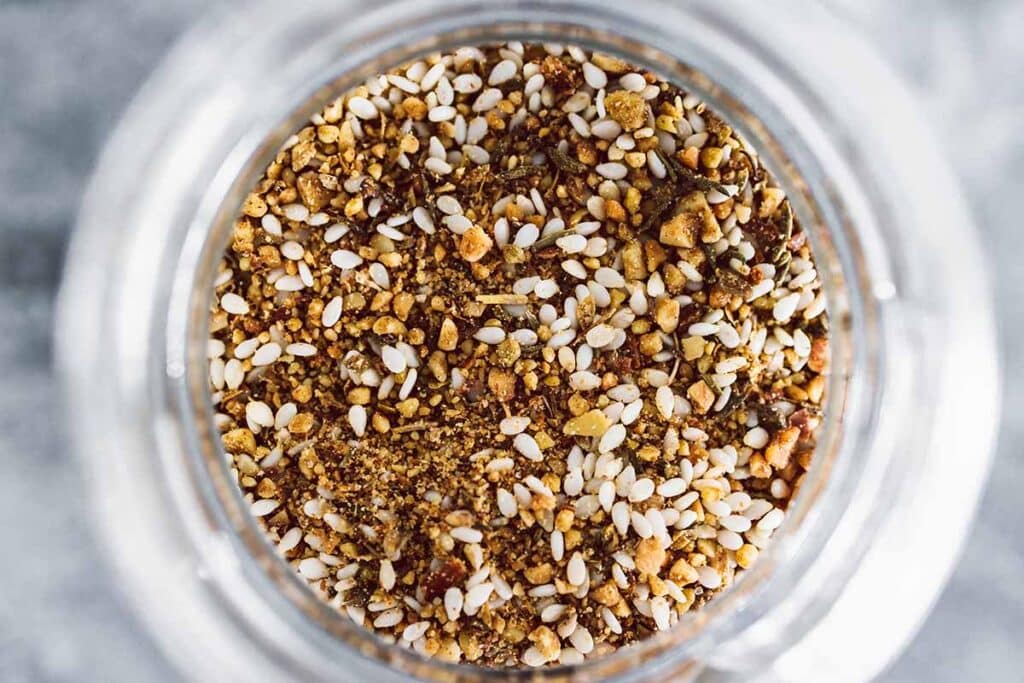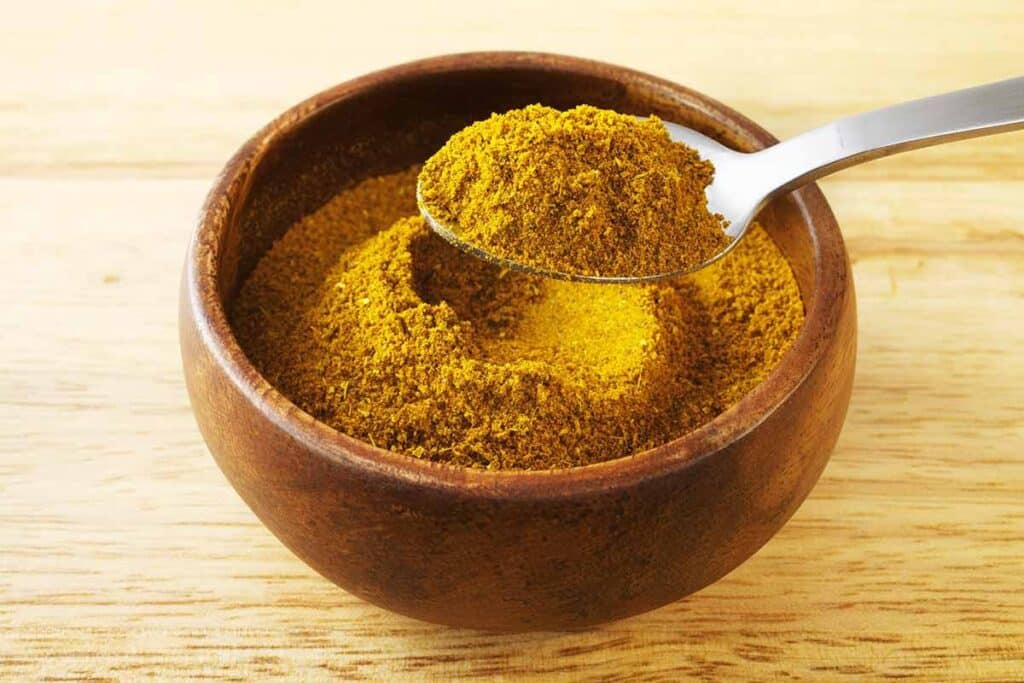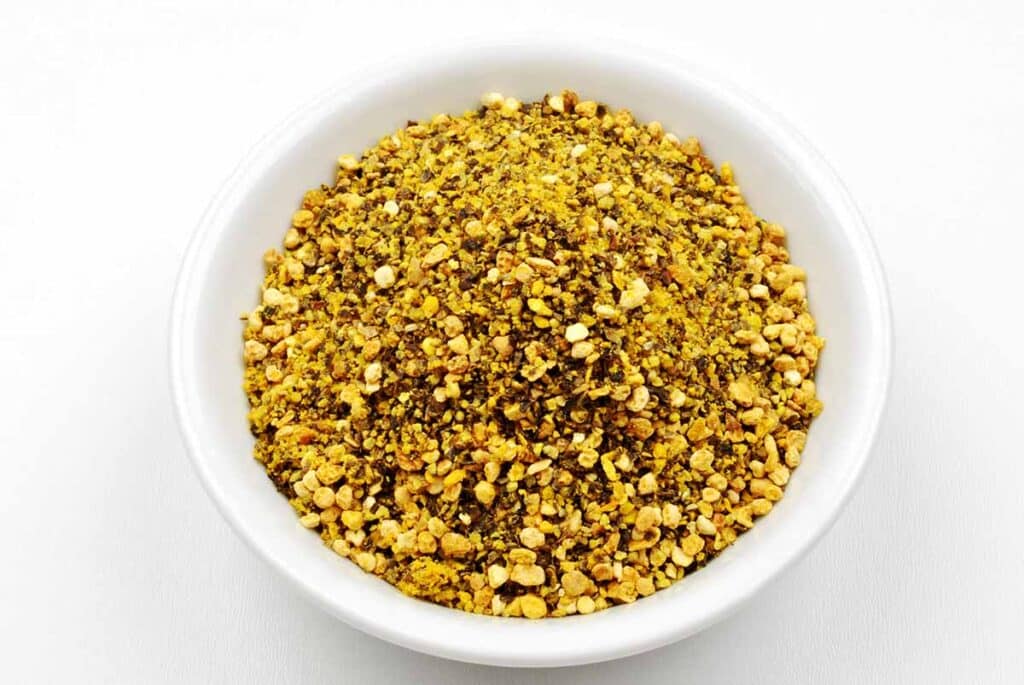On the hunt for a zaatar substitute? We’ve got plenty here. You can use these alternative ingredients if your recipe calls for this spice blend and you don’t have it available.
Zaatar seasoning is an indispensable element in Middle Eastern cuisine. It imparts a distinctive and delightful flavor to a wide array of dishes.

Za’atar or zaatar seasoning is a Middle Eastern spice mixture with an earthy, tangy, and herbaceous flavor. It has won over the taste buds of food enthusiasts worldwide.
This versatile spice blend boasts a rich history dating back to medieval times.
Regarding its ingredients, the exact composition of za’atar may vary. However, it typically combines dried thyme, marjoram, oregano, toasted sesame seeds, sumac, and salt.
The specific ratios of these ingredients depend on personal preferences and regional differences.
People commonly use this spice mix to add flavor to vegetables.
Za’atar mixed with olive oil makes a great meat rub and a dip for pita bread.
If za’atar is nowhere to be found in your pantry, you don’t have to go out and scour Middle Eastern markets for it. On the list below, we present a wide array of swaps. You can use them instead in your dishes so you can carry on cooking.
Here are your top choices for a za’atar substitute:

Creating your own homemade za’atar is a good option if you do not have access to store-bought ones. After all, this spice blend is easy to make.
To create your zaatar blend, combine equal parts of the following:
The good thing about this is that you can adjust the amounts of each ingredient to suit your taste.
Tips:
You can also create your own twist to make your blend truly your own. For instance, you can use fresh thyme or fresh oregano.

Among the best substitutes for zaatar is ground coriander. This spice that looks a lot like white peppercorns is mildly sweet. It also boasts a floral and citrusy flavor. In that case, it mimics the main ingredients of za’atar.
Do note that it does not taste as complex and as robust. For this reason, it is best to use it with ingredients that will not overpower it.
The good thing about coriander is that it is easily accessible and inexpensive. It is perfect when you are on a tight budget or in a hurry.
Tips:
Use a 1:1 substitution ratio with za’atar. Add coriander to your dish during the cooking process rather than after for the best results. Doing so ensures that you distribute its flavor evenly.

If you want to bring the heat up, you can also use shichimi togarashi to replace zaatar. This spice blend uses chili flakes, sesame seeds, orange peel, and nori. It hails from Japan and, unsurprisingly, brings a Japanese flair to your recipes.
Like the Middle Eastern spice blend, shichimi togarashi has deep and rich umami flavors. For this reason, it tastes great with meat, fish, and mushrooms.
The great thing about this spice blend is that it also works for dishes from both Thai and Indian cuisines.
Tips:
Since this Japanese spice blend packs a lot of heat, it is best to use it sparingly at first. Begin with using half of the amount of zaatar your recipe calls for. Add more depending on your heat tolerance.

Thyme has a comparable aroma and versatility to za’atar. For this reason, this herb is a great substitute for zaatar. Whether cooking chicken, lamb, or turkey, incorporate thyme instead of za’atar. This herb adds an herbaceous and slightly floral taste that enhances the dish’s complexity.
The intensity of thyme’s flavor may differ slightly from za’atar. However, its aromatic properties and overall taste can still make a difference.
Like other herbs, thyme is a widely available herb you can find in most grocery stores and spice aisles.
Tips:
Experiment between using dried or fresh thyme, depending on your recipes.
Lemon thyme is another decent alternative to za’atar due to its citrus flavors and wide availability. Although it doesn’t contain lemon, this variety carries subtle hints of citrus. Plus, this herb is available in many supermarkets, ensuring convenient and affordable access.
It’s important to note that while this herb provides a citrus touch, it may not replicate the exact intensity of za’atar. After all, zaatar’s distinct flavor comes from sumac.
For this reason, it is most effective in dishes that already feature bright and acidic elements.
Tips:
Separate the leaves from the stems of this herb before adding it to your dishes. Thick stems are tough so you should discard them.

Dukkah is a unique blend of nuts, seeds, and spices. It offers a delightful crunch and subtle nutty taste. Hailing from Egypt, this spice blend is another great zaatar substitute.
A typical dukkah mix combines cumin, coriander seed, sesame seeds, hazelnuts, and almonds. Like zaatar, the recipe varies widely but generally has a rich and aromatic profile.
While dukkah differs from za’atar in its ingredients, its crunchy texture and nutty undertones make it a decent swap.
Tips:
Serve dukkah with bread and feta cheese, or add it to a hummus dip. Try sprinkling tomatoes with dukkah or add it to your breading mix for the best results.
Lemon pepper is also a worthy zaatar alternative. It is a blend of dried lemon zest and cracked black peppercorns. Lemon pepper boasts a delightful combination of spiciness and vibrant citrus notes.
As a result, it can replace zaatar in most dishes without compromising on taste. An important consideration is the absence of sesame seeds in lemon pepper. You can easily fix this by adding sesame seeds to the dish itself.
Tips:
Always check the label of your lemon pepper for the inclusion of salt. If it does not have salt, you might have to add salt to your recipe for a better flavor match.
Italian seasoning is another close alternative to za’atar. It is a spice blend popular in Italian and Mediterranean cuisine.
Italian seasoning usually has sage, basil, rosemary, oregano, and parsley. Thyme and garlic powder are also common ingredients.
This blend of dried herbs closely resembles za’atar, so it works for most dishes. The widespread availability of this spice mix in various supermarkets and specialty stores is also a big plus.
Tips:
Rely on your sense of taste when using this seasoning as a zaatar replacement. Add a small amount first and add more as you go.
Zaatar seasoning typically includes several dried mixed herbs. It usually has sumac, toasted sesame seeds, dried thyme, and oregano. Dried chili peppers and salt are also common additions to za’atar.
No, za’atar seasoning blend and Italian seasoning are not the same. However, these two have common ingredients. For this reason, these spice blends can be substitutes for each other in recipes.
The traditional zaatar blend isn’t overwhelmingly spicy, but since the recipe for this blend varies, some versions can be spicy. That said, it is best to taste your zaatar blend before adding it to your dish.
Za’atar boasts a delicate mix of herby, earthy, and nutty flavors. It also has a subtle sweetness along with a citrus note. This spice mix is a great flavor enhancer that instantly elevates your dishes.
If you ever find yourself needing a za’atar substitute, fear not! There are numerous options available that you can use instead. One great option is to create your homemade za’atar blend. Doing so lets you customize the ingredient ratios according to your taste preferences.
Another alternative is ground coriander, which is easily accessible and budget-friendly. Shichimi togarashi, thyme, dukkah, and Italian seasoning are also excellent alternatives.





